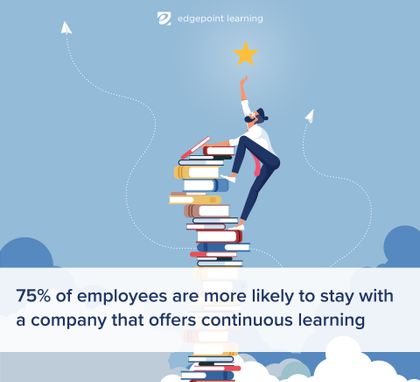How to Build a Culture of Continuous Learning at Work
Corey Bleich
🍿 6 min. read
Some people see work as a straight line: they earn a final degree or training certificate, snag that great job, and think their days of mandatory readings and assessments are behind them. Turns out, that’s not really how it works. The most successful, satisfied, and superlative employees are committed to continuous learning in their job. Continuous learning is about more than just memorizing information and passing a test. It’s actually the key to a more productive, flexible workplace with more engaged (and happier!) employees. Here’s what to know.
What is continuous learning?
Contrary to what some might think (hope?), learning is not something that happens only in the course of formal schooling. Things like on-the-job safety training may seem like an extension of the classroom, but continuous learning is deeper (and wider) than that. When you think about it, all of life is a process of learning.
More formally, continuous learning is about:
- Acquiring knowledge and skills
- Cultivating interest in problem-solving
- Letting the student’s curiosity drive the program
While some of the deepest discoveries are made when a person is intrinsically motivated to learn, it is possible to develop a continuous learning plan for the workplace that is engaging, interesting, and sustainable.
What are the benefits of continuous learning in the workplace?
So you’re maybe thinking “Why bother?” when it comes to continuous learning. This is understandable. After all, if your employees are trained to do a job, does it really matter if they keep learning, especially in an industry that is static?
However, because there aren’t many industries that are truly “set-it-and-forget-it” when it comes to changes and evolutions, it’s critical to recognize the benefits of lifelong learning in the workplace — especially if you need to convince the C-suite that it's worth the time and money.
Here are just a few of the many continuous learning benefits.
1. Improved job performance
Upskilling employees means that they are more flexible in their capabilities, now and in the future. This means they can collaborate with other people across specific jobs with better understanding about how everything fits together.
Consider a software engineer who learns a new programming language or a marketing manager who hones their skill in a different social media platform. These people are better at their job because they have a broader skillset that can be flexibly applied to novel situations.
2. Career growth and development
It’s official: 75% of employees are more likely to stay with a company that offers continuous learning. When you consider the cost of replacing an employee, this alone is a good incentive to get started.

3. A more innovative workplace
When employees are encouraged to learn and develop their skills, they are more likely to come up with new ideas and approaches. This can lead to new products, services, and processes that improve the organization's bottom line and make it more competitive in the marketplace.
4. An agile workforce
It’s a raging cliche to say that the only constant is change, but cliches become common sayings for a reason: they’re often accurate. And when it comes to today’s ever-shifting business landscape, you’ll need all the agility you can get. A workplace culture of continuous learning actually encourages employees to seek out the newest, the latest, and the next.
And this means your company is better equipped to handle whatever challenges lay ahead.
How to support continuous learning with your employees
Supporting continuous learning starts with recognizing its benefits and then setting up your workplace so that everyone can take advantage of new opportunities for growth and professional development. Here’s how.
Encourage a culture of learning
Continuous learning starts with a changed mindset. Employers can encourage a culture of learning by:
- Promoting knowledge sharing
- Creating mentorship programs
- Encouraging employees to attend conferences and workshops
This places high value on learning in collaboration and sharing knowledge as the foundation of how you do business. It’s critical that you model this value by offering paid time off or comp time for training when needed, too.
Provide on-the-job training
On-the-job training occurs in the course of regular work duties — it’s not a separate classroom-based event that then (hopefully) translates into practice. It is tailored to the specific needs of the employee and is one of the best tools to use when it comes to implementing continuous learning.
This training can be in the form of microlearning tools that offer precise bits of information when and where employees need it, or you might consider other types of digital performance support that are flexible and mobile-first.
On-the-job training:
- Provides employees with immediate feedback on their performance
- Allows for adjustments when an approach isn’t working
- Exposes employees to new challenges within (or slightly outside of) their current role
- Encourages collaboration across departments
- Ties directly to what an employee works on every day

Offer job rotations
In a related twist to on-the-job training, voluntary job rotations can break up the monotony of a regular work day by cycling employees across a wide variety of tasks. This helps to develop a broad range of skills and give employers more flexibility when it comes to staffing.
And staffing flexibility is crucial in this time of labor shortages, quiet quitting, and rage applying. Job rotations that are chosen by the employees result in employees developing skills in other areas, which means they are likely to be happier in their work and less likely to leave.
Provide feedback and coaching
Everyone wants to hear they are doing a good job. But there is a fine art to balancing praise and constructive feedback for an employee’s growth edges. It’s an art worth practicing, and it’s necessary to hone if you want to foster continuous learning.
Feedback and coaching can:
- Occur informally
- Be structured as a regular meeting
- Include a plan for future learning
Ideally, coaching and mentorship involve a balance of impromptu chats and more focused work sessions between mentor and mentee.
Offer additional training and development programs
Some training is mandatory (like anything related to safety concerns or regulatory compliance), but it’s important to offer training on topics above and beyond the compulsory ones. Workshops and seminars help employees grow personally and develop professionally.
Pro tip, though. Don’t just wait for an annual convention to keep employee skills sharp. Try:
- Synchronous and asynchronous classrooms online
- Augmented reality
- Scenario-based training
Provide access to independent learning resources
It’s no secret: people are more likely to learn when they are interested in the topic. If you want your company to embrace the idea of lifelong learning, provide employees with the resources they need to pursue the subjects they’d like to learn more about.
This includes developing a resource library that includes:
- Books
- Professional journals
- Online databases
- Off-the-shelf training on specific topics
These should be accessible to all at any time.
Roadblocks to continuous learning
Even with the multiple benefits of continuous learning in the workplace, the transition can be challenging. You may run into roadblocks, like organizational structures that do not support employee-directed learning, as well as complacency on the part of employees.
One way to address these roadblocks is to start by considering adult learning styles when designing a continuous learning plan. Structure training in a way that makes sense for adult learners, not their children. This takes into consideration the base of knowledge that employees bring with them and uses it to better integrate new skills.
Ensuring that training is accessible to all employees is key, too. This means designing and utilizing materials that people of every ability level can access.
Beyond that, asking for employee input into what they’d like (and taking it into consideration) is also important. No more top-down edicts — let the learning spring from the well of the people who are most affected by it.
How to get started
If continuous learning seems like one tall hurdle to leap over, EdgePoint can help. With tools you can use immediately, plus ground-up consulting and course development, we’ll get you started on a continuous learning plan that’s tailor made for your company.
Get in touch for a demo today!

